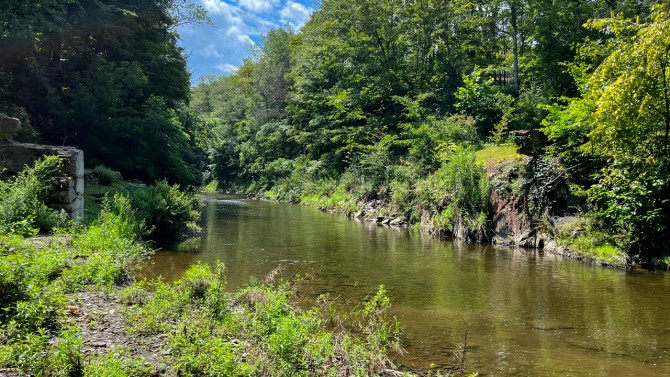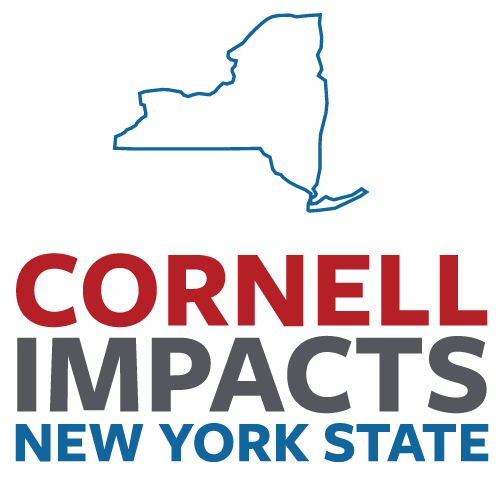The ecology of an upstate New York stream rebounded to its natural state within three years after a small dam was removed, highlighting how quickly aquatic ecosystems can recover, according to a new study.
Water resource managers are increasingly investigating removing dams to restore connectivity and improve aquatic habitats, water quality and fish passage, according to the paper.
"The research demonstrates the resilience of nature to recover from imperiled states," said Jeremy Dietrich '02, M.S. '15, principal aquatic ecologist at the New York State Water Resources Institute (WRI) in the College of Agriculture and Life Sciences (CALS), and lead author of the study appearing June 22 in Ecosphere. "We can show that the potential is there to reproduce these results at other sites," he said.
The findings also suggest that repeating these types of improvements at many sites within a watershed can potentially lead to cumulative benefits on a regional scale, Dietrich said.
Dams alter a stream's or a river's ecology by interrupting the transport of sediments and nutrients from above to below the dam. They also impede the movement of aquatic organisms, including American eels that migrate upstream.
At WRI, Dietrich has collected data from 16 sites across New York state, which he has shared with the New York State Department of Environmental Conservation (NYS DEC). "The DEC is realizing removing small dams can be an easy way to demonstrate powerful, tangible ecological benefits to local stakeholders," Dietrich said.
In the study, the researchers worked with a landowner in the Hudson River Estuary watershed who had a 12-foot dam on her property that had been built in the early 1960s for a water supply reservoir. Each dam has a permit associated with it, and as the structures age they become costly to keep to code, Dietrich said.
"It can generally cost about $1.2 million to fix up a small dam, or you could take it out for about $400,000 and not have to worry about it," he said.
Dietrich developed a monitoring protocol to test the stream's health and gauge recovery. In June 2016, Dietrich collected baseline conditions before the dam was removed. After the dam was removed in September that year, he monitored the stream above the dam to the stream's end in June 2017, 2018, and 2019.
Before the dam was removed, the stream bed sediments above it were sandy and silty. Below it, the stream bed consisted of bedrock, boulders and cobbles. A stream bed's makeup provides important habitat for spawning fish and macroinvertebrates. "The dam creates suboptimal conditions for organisms, and you lose that natural habitat heterogeneity," Dietrich said. But within three years of the dam's removal, the upstream and downstream habitats became almost indistinguishable and the differences in types of macroinvertebrate species living in the upper portion of the stream compared to the lower areas disappeared.
The dam had reduced the water velocity and created a pond above it. That allowed the water to warm, reducing its capacity to hold dissolved oxygen. The pond also collected upstream nutrients from forest runoff, limiting availability below the dam. Removing the dam restored the stream's water flow and movement of nutrients downstream.
Migrating fish such as juvenile American eel were able to move upstream to access rearing habitat. By the third year after the dam was removed, water quality levels improved significantly within the upstream (former impoundment) area and increased above pre-removal levels within the downstream reach, according to the NYS DEC's Biological Assessment Profile score.
"If you just look at the stream after removal, you wouldn't even have known there was a dam there," Dietrich said.
The study provides a methodological framework for successfully restoring aquatic ecosystems by removing small dams, he said. "I think increasingly people have a need to show good news in a broader media environment of gloom and doom," Dietrich said.
Cornell co-authors include Patrick Sullivan, professor emeritus in the Department of Natural Resources and the Environment (CALS). Other co-authors include Alison Rickard at the University of California, Santa Barbara; Suresh Sethi at Brooklyn College; and Scott Cuppett at the NYS DEC Hudson River Estuary Program.
This research was funded by the NYS WRI and the NYS DEC's Hudson River Estuary Program, with support from the New York State Environmental Protection Fund.








